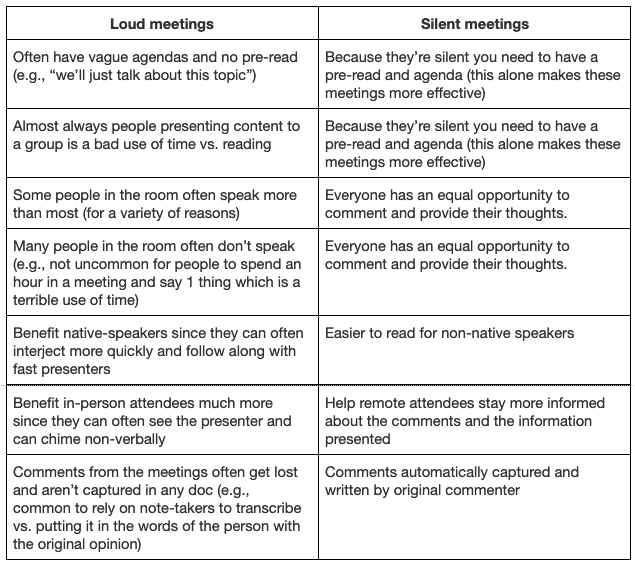Feels that your meeting is somehow ineffective? try silent meetings.
This isn’t really a new type of meeting, but since the dotcom and the rise of the startups, this kind of meeting helps people especially leaders to avoid joining busy-bandwagon and meeting hell. It’s scientifically proven effective in various scenarios, but we need to be well prepared.
✅ What are Silent Meetings?
“Silent Meetings” are meetings where most of the time is spent working and not talking. When done correctly most of the meeting is spent silently working together.
TL;DR
For meetings that have a silent approach, please do the following:
- Submit pre-reads 24 hours before the meeting
- Make google slide or google Docs as self-contained and understandable as possible (ex: definition of terms); otherwise, they may be unusable without a conversation with you – which does not scale.
- Make liberal use of slide notes and even completely separate hidden slides to explain your reasoning, provide internal links to artifacts, include results of google comments discussions, etc.
- Please limit the content to fit into the time slot allocated to you. E.g. assume it takes 1 minute to silent read each slide. The best practice is to limit to 10 slides.
- Send an email both the i) Google Slides Deck / Google Doc with *comments-enabled* and ii) PDF copy of the Deck / Doc
- Update the agenda with your pre-read when it becomes available.
- Each agenda item will generally commence with a 10-minute silent read of the presentation materials, followed by discussion and Q&A.
- Consider “View” access to all people in your company (Not public ! ensure to limit access with company domain only) if the deck/doc is not confidential.
- As with all documents at company, a document should not be considered final for any stage as long as there are google comments in it; you need to resolve all google comments. For material content, prefer placing discussion resolutions into the actual presented slide. However, you can also use the slide notes or additional (hidden) slides.
✅ Why Silent Meetings?
Silent meetings fix many issues that are common with “loud meetings”:

Describes loud meetings vs. silent meetings. Silent meetings are better for remote attendees, non-native speakers, introverts, and broadly for attendee equality.
✅ So how does one have a Silent Meeting?
Before the meeting you’ll need a Google Doc with:
An agenda that includes:
- Meeting Outcome Statement (i.e.,what do you want the meeting to achieve?)
- Process (“Read doc 20 minutes silently and then discuss for 10”)
- Assigned facilitator
The “pre-read”
- The subject matter to be discussed that fits in ½–⅔ of the allotted time
- A good rule of thumb is it should take less than 10 minutes to read in a 30-minute meeting. An x-minute pre-read can grow to 2x if there are lots of comments, so 10 minutes becomes 10 very easily (especially if it’s a controversial topic or if it’s an area that is new to the commenters)
- Note 1: “pre-read” is a misnomer since this is read in the meeting. This is the case because most people don’t have time to pre-read — this also ensures everyone operates from the same base of information. (I believe this is a Jeff Bezos nuance)
- Note 2: Try to include any information needed in the pre-read itself (i.e., avoid using the Appendix, or clicking out to other docs as much as possible since there is leakage)
- Note 3: If a meeting is very large consider breaking up into sections to read-comment. I think optimal reading size per piece is ~20 mins. I’ve done 1 hour per piece and I find people zone out a bit which might be fine for a full day session though.
Then, start the meeting by:
- Pre-reading for the amount of time determined AND commenting in the doc
- Mention that attendees should “Read entire doc before commenting. Often times answers to questions are found later in doc.”
- Readers should then go back to the beginning after finishing to read the comments and reply.
While everyone is reading, the facilitator should:
- Review the comments as they occur and then identify topics that require in-person discussion (e.g., identify controversial topics or areas of disagreement and call them out upfront if possible)
- Call an end to the silent reading when time is up
- Guide the discussions to the areas identified
- Identify the next actions 5 minutes prior to the end of the meeting and have clear people assigned to each.
- Note: The role of the Facilitator is super important because they need to sort through the comments and guide the discussion. There is such a thing as a skilled facilitator.
✅ When should you use Silent Meetings?
I’m not sure. I’m still learning but here is my rule of thumb:
- More than 10 people? Absolutely.
- More than 6 people? Yes
- 4–6: Maybe
- <4: Maybe?
References
- https://medium.com/@gascasf/everything-you-always-wanted-to-know-about-running-silent-meetings-but-were-too-afraid-to-ask-5eacbc2da064
- https://medium.com/swlh/the-silent-meeting-manifesto-v1-189e9e3487eb
- https://monday.com/blog/teamwork/5-best-practices-for-silent-meetings/
- https://qz.com/work/1422191/why-silent-meetings-at-work-are-effective-and-inclusive/
- https://www.amazon.com/Surprising-Science-Meetings-Lead-Performance-ebook/dp/B07KKM9CXY